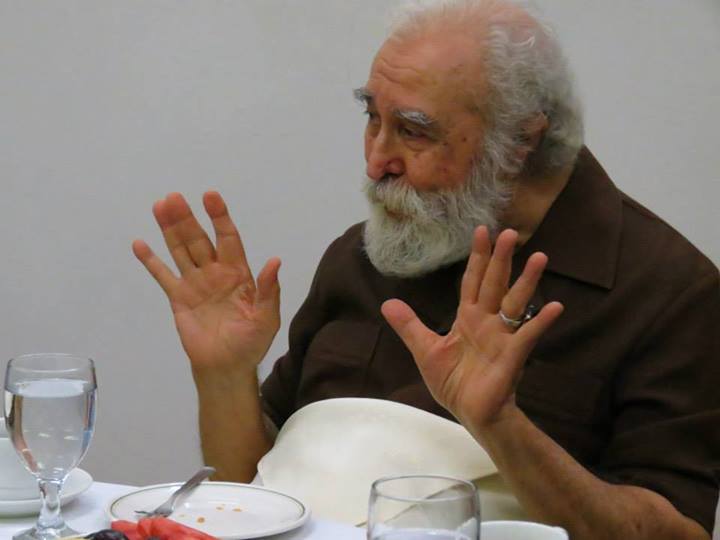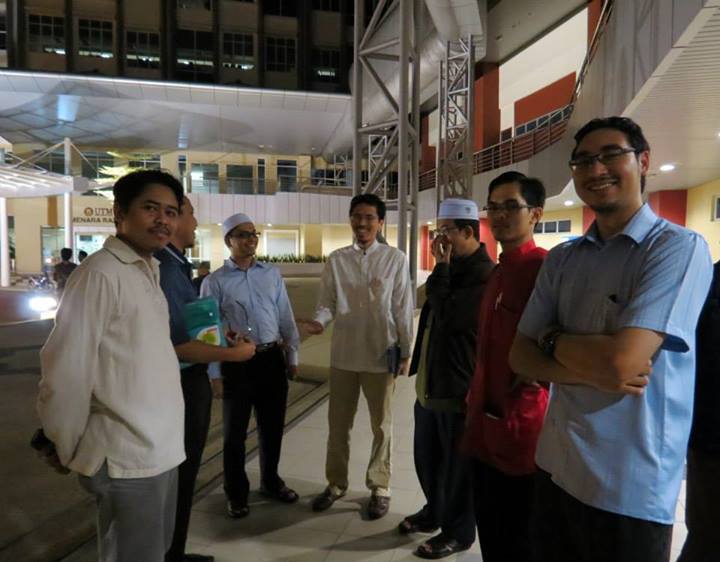Summary of Saturday night lecture 3rd Series with Tan Sri Professor Dr. Syed Muhammad Naquib al-Attas
28th September 2013
“Language and the Integrity of Concepts”
On the 28th of September 2013 Professor Syed Muhammad Naquib Al-Attas continued upon the themes which he had earlier discussed in the previous instalment, which was focussed upon the concept of nationhood and the importance of the national language. Held in the Razak Hall with an audience exceeding 500 which includes a group of about 100 Cadets from INTAN(the national institute of public administration), the professor began by recapitulating on what produces the right sentiment of solidarity which is required in the process of nation building?
In the previous lecture he had highlighted 4 major factors and these are; 1. A shared history 2. A common race or ancestry 3. A common religion and 4. A common language. In this lecture he had clarified that they are two forms of unity when it comes to a nation, that which is fluid and that which is solid. The first kind of unity is achieved over a long period of time and he likens it to that of metals which have been melted and they intertwine into a unified structure. As for the second kind, one must imagine a few solid objects bounded together by a rope, and this unity is dependent upon the strength of the rope, and whenever clashes or arise, the strength of the rope will continuously be tested in binding together the solid objects.
Professor Naquib brings forth the example of races or nations which have stood the test of time, like that of the Arabs and the Semites which came from the same ancestry. From the prophet Ibrahim and his sons Ismail and Ishaq came forth 2 major nations, the Arabs and the Jews. Their descendants inhabit the Mediterranean basin and today, even as they are divided into different nation states, there is something that unites the Arabs that transcend the boundaries of the nation state. He then recounts some of the other major nations in the world today, the Indian, the Chinese, the Europeans which have taken long periods of time before the sentiment of unity gradually formed and crystallized.
He states that nations continue to be formed from unities found within tribes and ethnicities to something as big a civilization. With this background when he talks of the history of the nation of Malaysia, professor Al-Attas talks about the history of the Malay language and its people before the forming of Malaysia and Indonesia as nation states. He recounts that the Malay language has been the lingua franca or the common language spoken by people across the archipelago which gained its prominence due to the influence of Islam.
The Malay language was consciously chosen by the missionaries who spread Islam in this region to be the vehicle for propagating the religion of Islam[1]. The result is enrichment in the vocabulary of the language, because the propagation of the religion of Islam utilizes the instrument of language to explain central concepts such as the nature of God as well as a projection of the basic elements which form the worldview of Islam.
The Malay language also gained prominence in that the propagators of Islam had also introduced the Jawi script (Arabic script which is vocalized in the Malay language with ingenious additions of alphabets so as to vocalize specifically Malay phonemes not available in the Arabic). The Jawi script is utilized throughout the Malay archipelago and it even had reached the Philippines. Textual evidence shows that the Friday Khutbah in parts of the Philippines were already in the Jawi script. The coming of the Spaniards to the Philippines, like the other imperialists throughout the archipelago however had halted this process of Islamisation[2].
Through the gradual intensification of this process, what was slowly emerging was a unified identity based on language, a written script, but more importantly a worldview derived from the religion of Islam, which as a religion transmits its norms which influence the ethics of the Malay people.
As from the previous lecture, Professor Al-Attas recounts his experience in the moments leading towards the forming of Malaysia as a country and he noticed that the politicians did not have these important ideas in their minds, but were more focused instead on issues of the economy and socio-political issues. Through his constant efforts at bringing these ideas into public discourse some of the politicians criticized these ideas as being too ideal, that he was only talking of the metaphysical, but not addressing what they considered real. Today what was thought at ideal in fact does have effect on the physical like the case of Singapore, which as a nation had separated herself from Malaysia, and in the process gradually severing herself from the roots of the Malay world.
While he went away for studies in the United Kingdom in the 60’s, he found that the Jawi script had been abolished upon; The streets now carry the Latin script along with Latinized spelling. In his various capacities, as the dean of the faculty of Malay letters in University Malaya, In his founding of IBKKM in UKM he has been persistent in defending ability of the Malay language to be the national language as well as a language for scientific and academic activities[3].
Severing the Malay language from the Jawi script would have catastrophic consequences for the Malay language in that the generation raised only to read the Latin script will effectively have no access to literature, intellectual, scientific and religious which had been produced by the Malay civilization. The severance will also distance the speakers of the Malay language from recognizing the Arabic-Quranic origins of words whose lexical meanings are based upon the root structure of the Arabic language.
These distinct features of the Malay language owes to the fact that it belongs to the family of Islamic languages which includes Urdu, Turkish, Persian and others which went through the same process of Islamisation[4].This process comes about through the infusion of Islamic concepts which effect a shift in the projection of the Worldviews of these peoples, evident based on a semantic analysis of central key concepts. This process is done ingeniously in that part of its aspect is the infusion or ‘sprinkling’ of Arabic key terms from the Quran which will be the same throughout the Muslim world in the various Islamic languages. Such words include ‘Ilm, ‘Adl, Allah, Dunya, Akhirah etc.
The process is also creative in that the Islamisation process in its aspect looks at existing words and concepts from the available language and effect a semantic shift so that the concept is absorbed into the conceptual ambit of the worldview of Islam. Using examples from the Malay language Professor Al-Attas demonstrated how the understanding of ‘Existence’ was Islamised. The Malays, before the coming of Islam used the word ‘Ada’ to mean being-existent, and this like its synonym ‘Isi’ (flesh) means for them to be contained within space and time. The arabic equivalent would be term maujud. In discussing the nature of God, these terms fail to connote His existence which transcends space and time and where existence is part of His attributes, thus the term Wujud is introduced to discuss His attributes, but the term ‘Ada’ and ‘Mengadakan’ in the sense of causing the occurrence of something in space-time is maintained to avoid conceptual confusion[5].
Another example of this process is when they distinguished between two ways of knowing, that of ‘Ilm(in the sense of discursive knowledge or the latin Scientia) and Ma’rifah( Illuminative knowledge, that which is arrived through bestowal). The Malays use ‘Ilmu Pengetahuan’ for the former and ‘Ilmu Pengenalan’ for the latter. Although the utility of Science as a medium of knowing is not disputed, Ma’rifah or Ilmu Pengenalan occupies a higher and more central position.
Prof Naquib used the example of getting to know a person[6]. Whereas it is true that by using one’s cognitive and scientific abilities one may gain innumerable data about the person: his height, weight, his biographical history etc, the more valuable ‘knowledge’ is obtained through friendship with him, through which after its consolidation he reveals his hopes and fears, likes and dislikes in other words his inner dispositions which are unknown to others except through his own self-revealing.
Likewise is the case with man and His God. Through his efforts at reasoning he may chance upon the knowledge that there is no God but He, and begin from there to see traces of His activity upon the physical world and in his own self, yet, the more valuable, the crown of knowledge is to be found through long periods of worship and conducting his life in accordance with the demands outlined in the religion of Islam so that perchance by drawing close to his creator-cherisher-sustainer man may glimpse something of the nature of the Illuminative knowledge which is a gift from his Lord. In the words of the Quran in surah al-‘Alaq, ‘Prostrate, and draw near’.
By
[1] This conclusion has been argued for and explained in his Historical fact and fiction(2011,UTM Press)
[2] For his definitive theory on the Islamisation of the Malay Archipelago refer to ‘Islamisation of the malay archipelago’ his lecture which is published as an appendix in his Islam and Secularism(1993,ISTAC). For the meaning of this process and its history see ‘Educational Philosophy and Practice of Syed Muhammad Naquib Al-Attas(Wan Mohd Nor Wan Daud,1998,ISTAC)
[3] Read more about his biography iEducational philosophy, Wan Mohd Nor(1998)
[4] His clarification of the concept of Islamic language can be found in his ‘Concept of Education in Islam’(ISTAC)
[5] The semantic analysis of the concept of Wujud ,ada, isi, and other central Malay terms can be found in his Mysticism of Hamzah Fansuri( UM,1970)also refer to Wan Mohd Nor(Educational philosophy)
[6] This explanation is found in ‘Islam: The concept of Religion and the Foundation of Ethics and Morality’ published as a chapter in Islam and Secularism(1993) ,Prolegomena to the Metaphysics of Islam(1995)



